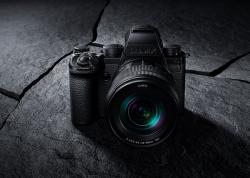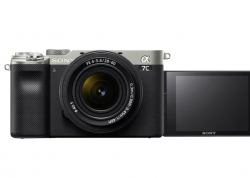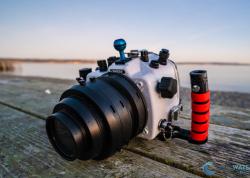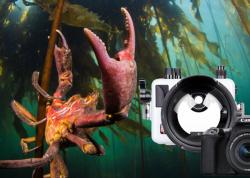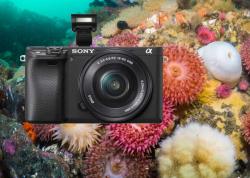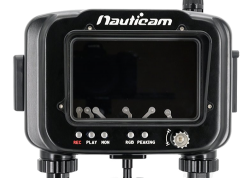OM System TG-7 Review
After a lot of anticipation, the OM System (Olympus) TG-7 has been announced as the successor to the Olympus TG-6, which was quite popular in 2019 with underwater photographers, especially macro shooters. Four years later, Olympus has since been acquired by OM System (aka Japanese Industrial Partners). With the company under new management we were hoping for a revamped, improved, and reimagined TG-7. Unfortunately, some TG-6 shooters will be met with disappointment. Much like the "upgrade" from the TG-5 to the TG-6, the TG-7 is a repackaged Olympus TG-6 with very minor upgrades for underwater photography - for an even higher price point of $549.99. This is surprising to see considering the fact it's been six years since the TG-5 was announced in 2017 - without a major update since. Even with inflation, the TG-7's pricepoint is making professional-grade APS-C cameras a lot more enticing. Take the Canon R100 for instance. This entry level mirrorless camera clocks in at $479.
Even though the sample images captured with the TG-7 will be the same images you've seen in the Olympus TG-6 review, we still took the TG-7 diving for you to see real results! So read the full TG-7 review below with sample underwater images from our dives with the camera in the Pacific Northwest and Hawaii.
OM System TG-7 Underwater Housings
The one upside to the new camera is that it is so similar to the TG-6, it will fit in current Olympus TG-6 housings. So be sure to check out Bluewater Photo's overview of the OM System TG-7 underwater housings options available, including the Ikelite TG-7 housing, Marelux TG-7 housing, Isotta TG-7 houing, Kraken TG-7 housing, Nauticam TG-7 housing, and Olympus PT-059 housing.
Ikelite TG-7 Housing & Inon Accessories
We wanted to give a special shoutout to Ikelite and Inon for providing us with the housing and accessories for this review. Ikelite's housing was a pleasure to dive with. As you can see in the photo above of my dive buddy, Avyay, the whole system is very small and perfect for new photographers. Avyay is a new diver and photographer, and he was overjoyed to try out the Ikelite housing on our dives in Hawaii. You can see his manta photos in the review below that were as simple to take as pointing and hitting the shutter button. The Ikelite housing was easy for him to operate as every button is labled and it's simple to place the camera in the housing, shut the latch and you're good to go! The back of the housing is completely clear which makes it easy to see the camera and monitor that everything is ok during the dive. The Ikelite housing is the only housing that has the ability to use the FCON-T02 fisheye lens for those looking for a true wide angle set up for the camera. So be sure to read our review of the FCON-T02 and Ikelite housing here.
When I took the camera back to the Pacific Northwest, I had the opportunity to take some photos with Inon's newest accessories, including the Inon S220 strobe, Inon mega float tube, Inon telescopic arms, and Inon wide lens.
Shop at Bluewater Photo for OM System TG-7 Camera and Housings!
Ikelite Olympus TG-7, TG-6 Housing
Nauticam Olympus TG-7, TG-6 Housing
Isotta Olympus TG-7, TG-6 Housing
Olympus TG-7, TG-6, TG-5 Underwater Housing PT-059
Our Top Olympus TG-7 Underwater Bundles and Packages:
Olympus TG-7, TG-6 Snorkel Package
Olympus TG-7, TG-6 Macro Package
Olympus TG-7, TG-6 Video Package
Olympus TG-7, TG-6 Ultimate Package
Olympus TG-7, TG-6 Housing and Strobe Package
Olympus TG-7, TG-6 Camera and Housing Bundle
Great Value Package for the Olympus TG-7, TG-6
OM System TG-7 Specifications
- 12 megapixel, 1/2.33" sensor (smaller than Canon G7X Mark III and RX100 VII, resulting in less dynamic range)
- Olympus TruePic VIII image processor
- Waterproof (50ft without housing), shockproof, crushproof, freezeproof
- Fast f/2.0-4.9 lens with 4.5mm - 18mm focal length (equivalent to 25mm - 100mm)
- Sensor-shift image stabilization (up to 2.5 stops)
- Minimum working distance 1cm (in super macro mode)
- ISO range 100 - 12,800
- 25 autofocus points with Single AF and Tracking
- 4K@30p video recording (approx. 102 Mbps bit rate)
- High Speed Movie mode with 1920x1080@120fps / 1280x720@240 fps / 640x360@480fps
- 4K timelapse video
- Pro Capture mode for 20fps image capture
- Shutter speed 4 sec to 1/2000 sec
- Custom white balance (4 slots)
- Built-in flash
- SD storage (SD, SDHC, SDXC)
- RAW and jpeg shooting
- WiFi capabilities, including camera control via smartphone
- Action track sensors record location, temperature, direction and altitude data
- Weight (approx): 249g / 8.72oz with battery & memory card
- Dimensions: 113mm x 66mm x 32.7mm (4.43in x 2.6in x 1.23in)
- Battery life (CIPA): 330
What's New? The TG-7 vs the TG-6
As we mentioned, not much is new with the OM System TG-7 vs the Olympus TG-6 - and certainly nothing that will excite underwater shooters. That said, here are a few updates with the camera:
1. The TG-7's charging and data transfer port has been updated to USB-C.
2. The TG-7 will automatically rotate your video vertically if you take vertical videos for social media.
3. There is a new construction mode for people that need to bring the camera to worksites.
Image Quality
The TG-7 hosts the same 12 megapixel, 1/2.33" sensor as the TG-5 and TG-6. This means you can expect the same great image quality from the TG-7 as its predecessors. While the dynamic range isn't quite as good as 1" compact cameras that are currently on the market, it does a great job for macro images that don't often require as wide a dynamic range as wide angle images do (i.e., sunball shots). The microscope mode on the TG-7 will continue to please macro aficionados.
Body & Build Quality
The TG-7 is built with the same sturdiness as the TG-6. It is freezeproof to 14F/-10C, crushproof to 220 lbs/100kg, and shockproof from 7ft/2.1m. The camera is also waterproof to 50 ft, so if you get a minor flood at depth in your underwater housing, you camera is likely to survive!
Battery Life
The TG-7's battery life is rated for 330 shots. In using the TG-6, we've started to recommend changing the camera battery after each dive, or every other dive if you don't take many photos. We would recommend buying a couple extra batteries if you intend to go on a dive trip with the TG-7. That said, the TG-7 did last up to three dives when I was diving with it in Hawaii.
Strobes and TTL/RC Capability
Strobes are underwater flashes that bring colors and details back into your photos. Through-the-lens (TTL) is a strobe setting where your camera controls your strobe power based on its own light metering. The internal flash trigger is transmitted to your strobes via fiber optic cables, and your strobes fire with a corresponding strength. You can get optical TTL when using fiber optic cables with the Sea & Sea YS-03 Solis strobes, Sea & Sea YS-01 Solis Strobes, Inon s220 strobes, Apollo 28 strobes, and Apollo 33 strobes. TTL works in all modes - P, A and auto modes.
The TG-7's built-in flash, which triggers your strobe, has a maximum recycle time of 4 seconds. This is a while to wait for your camera to catch up to your strobe before taking the next shot. One alterative is to not shoot in TTL mode. If you turn your strobe to manual and set the manual flash setting on the camera to 1/32 power, you should be able to trigger your strobe, but shoot quicker.
The Best Option for TTL (auto strobe exposure)
When it comes to getting the right exposure with your underwater strobe, Ikelite and Sea & Sea go above and beyond with Ikelite's RC1 TTL converter, and Sea & Sea's RC compatible YS-D3 duo strobe. The RC1 TTL converter is a special device that can only be used with Ikelite DS strobes. This device takes the RC flash signal from your Olympus TG-6 and tells the Ikelite DS strobe what exposure you need for your shot. It's extremely accurate and produces great results! We used the RC1 TTL converter in several of our TG-7 sample shots. For the TG-7 we recommend the DS 51 strobes, and if you need a lot of light for wide angle, the DS 160s. The Sea & Sea YS-D3 duo performs just as good! This strobe is great for both wide angle and macro.
Microscope Mode
The Tough line's microscope has been legendary among macro shooters since its inception. The TG-7 has the same microscope mode functionality as the TG-6. It enables you to take incredible close up photos of small subjects without an additional macro lens. You can also use supermacro autofocus in the TG-7's other modes - allowing you to do "microscope mode" in aperture priority. Pro tip: make sure you zoom the camera in all the way and get close to your subjects when in microscope mode!
Om System TG-7 Underwater Video
The OM System TG-7 is a good camera for underwater video, but not our first choice for underwater video at this pricepoint. It is capable of capturing 4K video, but we recommend shooting at 1080/60p so that you can slow down your footage in post processing for better stabilization. Perhaps the best video feature of the TG-7 is the fact that you can film video in microscope mode for macro subjects.
Conclusions
When I first heard of the OM System's TG-7 announcement, I was quite excited to see what new tech OM Systems would bring to the table with their first Tough line camera. After pouring over specs sheets and watching reviews, I became incredulous. After all, the major photo websites had been raving about the new release. But it seems as though the internet has a short memory. There is nothing substantially different between the TG-7 and TG-6.
OM Systems, or rather Japanese Industrial Partners, is at its core a private equity firm. Their job is to turn around struggling companies to make short term profits. I had hoped that Olympus's transition to OM systems would be an exception. But it's clear here that the release of the TG-7 was a ploy to increase the price of the camera and generate more sales from customers unaware that this isn't an upgrade. And we're happy to call them out on it.
RECOMMENDED ARTICLES
SUPPORT THE UNDERWATER PHOTOGRAPHY GUIDE:
The Best Service & Prices on u/w Photo Gear
 Visit Bluewater Photo & Video for all your underwater photography and video gear. Click, or call the team at (310) 633-5052 for expert advice!
Visit Bluewater Photo & Video for all your underwater photography and video gear. Click, or call the team at (310) 633-5052 for expert advice!
The Best Pricing, Service & Expert Advice to Book your Dive Trips
 Bluewater Travel is your full-service scuba travel agency. Let our expert advisers plan and book your next dive vacation. Run by divers, for divers.
Bluewater Travel is your full-service scuba travel agency. Let our expert advisers plan and book your next dive vacation. Run by divers, for divers.














